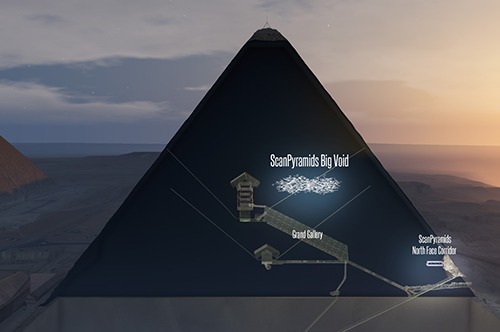Home > Highlighting JAPAN > Highlighting Japan February 2018 > Science & Technology
Highlighting JAPAN


Cosmic-Ray Particles Shed Light on Pyramid’s Secrets
A team of Japanese researchers has discovered a large and hitherto unknown void in a mystery-shrouded pyramid in Egypt.
The Great Pyramid of Giza, also known as Khufu’s Pyramid, is estimated to have been built between 2580 and 2560 BCE. Having a base of 230 meters and standing 139 meters tall, it is the largest of Egypt’s stone constructions.
Despite the discovery of the King’s Chamber, Queen’s Chamber, Grand Gallery and other features such as corridors and shafts, the precise internal structure of Khufu’s Pyramid and its method of construction remain a mystery. In 2015, a joint international research project dubbed ScanPyramids was launched in a bid to reveal the secrets of the Khufu and three other pyramids. In the project, research institutions from Egypt, France, Canada and Japan are investigating the pyramids using world-leading non-invasive technologies.
The core technology of the project is Nagoya University’s cosmic-ray muon radiography, which uses muons, elementary particles that are continually falling to Earth, for imaging the internal structure of an object.
“Normally, non-intrusive internal examination of a human body or an object is conducted using X-rays. However, X-rays cannot penetrate an object that is 1 meter or more in thickness. Muons on the other hand can pass through even rock more than 1 kilometer thick. Using muons, we can image the inside of a huge structure, such as a pyramid, just like X-ray imaging,” explains Kunihiro Morishima, Designated Assistant Professor at the Institute for Advanced Research, Nagoya University.
Attempts to use muons to image the inside of a large object have been made since the 1960s. However, high-resolution image data could not be obtained because muons themselves were difficult to detect. Nagoya University developed an automatic reading device combining a microscope and a computer as a new method of physical analysis to replace visual inspections made using a microscope. By increasing the processing speed of this device, the team opened up the potential for practical application of cosmic-ray imaging that makes use of the high resolution offered by nuclear emulsion film, a high-precision muon detector.
A nuclear emulsion film is a radiation detector in the form of a thin sheet. It is a transparent plastic sheet with both surfaces coated with a 0.07-millimeter-thick emulsion layer. The film can be placed anywhere because it is lightweight, compact and does not need a power supply.
When muons pass through a nuclear emulsion film, they leave tracks on the emulsion layer. An almost constant number of muons reach the ground from all directions with an almost constant directional distribution. Placed in a monitoring point, a nuclear emulsion film permits recording of a 3D image of tracks showing how many muons have reached it and from which directions. By reading the image or tracks with the Hyper Track Selector, a device that was developed by Nagoya University, the internal structure of the object located in the direction from which the muons came can be shown three dimensionally. By using this technology, Nagoya University has succeeded in imaging the inside of a volcano, a nuclear reactor and other objects.
“Because of its compact size, a nuclear emulsion film can be placed anywhere, which is its advantage. Microscopic devices have improved in terms of both resolution and processing speed, so we can see clear images quickly,” says Morishima.
The team led by Morishima began to observe muons in Khufu’s Pyramid as part of the ScanPyramids project in 2015, placing nuclear emulsion films side by side in various configurations covering a maximum of 8 m2 on the floor of the Queen’s Chamber. An analysis of approximately 11.0 million muons, recorded on a total of 1.8 m2 of nuclear emulsion film included in the above, indicated that a huge and hitherto unknown void more than 30 meters long appeared to exist approximately 40 to 50 meters above the Queen’s Chamber, or 60 to 70 meters above the ground. In response, the High Energy Accelerator Research Organization (KEK) of Japan and the French Alternative Energies and Atomic Energy Commission (CEA) made observations using their own methods and validated the finding.
The finding was published in the British science journal Nature in November 2017 and received an enthusiastic response from all over the world.
“We have yet to identify the shape of the void. Moving forward, we will place the nuclear emulsion films in other parts of the pyramid, such as along the Grand Gallery, to obtain a detailed shape of the void three dimensionally,” says Morishima.
Determining the shape of ScanPyramid’s huge void will be an excellent clue in trying to find the purpose for which the chamber was made in addition to explaining how the pyramid itself was built. There are great expectations for the analyses to be made in the future.

© 2009 Cabinet Office, Government of Japan






